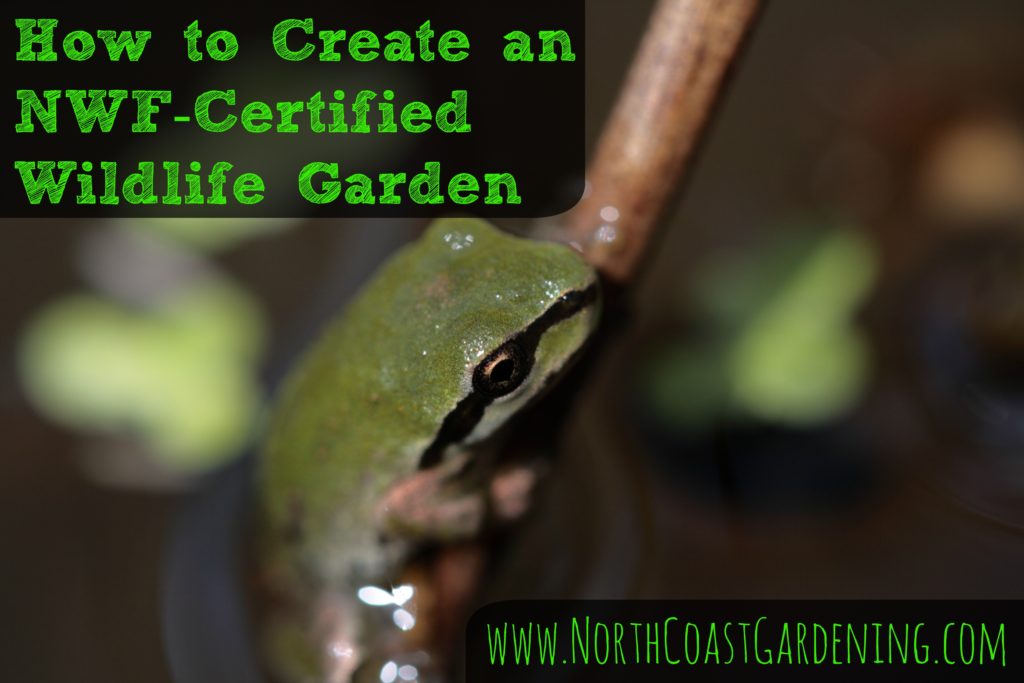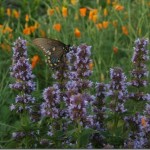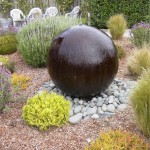
The National Wildlife Federation has a really effective educational program that allows people to certify a home, school, church, or business garden as a wildlife habitat garden. Why is this educational? Because in the process of certification, you learn a lot about how to create a mini ecosystem in your garden. Then, once you’re certified, everyone who sees your sign asks about it, and its a great way to start conversations with people who are interested in habitat gardening, but might not know where to start.
Many people do the wildlife habitat garden certification process with their kids or with neighboring children, and do a few gardening or habitat-related projects to prepare for certifying, like create a toad abode or a butterfly puddling area. Older kids can help by creating intricate log or stone piles (some insane inspiration here), or by making a bee house.
Another reason people certify their wildlife habitat garden is if they often have guests to the garden and think it would be a fun way of starting conversations about native plants or other things people can do in their garden to support wildlife.
Still other people are new to gardening and find the wildlife habitat garden certification process a fun goal. Creating each of the required attributes for certification puts you in touch with so many natural processes, that it really increases enjoyment of your garden and being outside and health care. If you feel like life is passing you by too quickly, and you want to slow down and smell the flowers more often, certification is a great excuse to do just that.
If you live in Humboldt County – Arcata, Eureka, McKinleyville, and surrounding areas – and think you might need help, I am one of only 12 landscapers across the US ever recognized as an approved landscaper by the National Wildlife Federation, and I’d be happy to help you either as a landscape designer to help create an overall plan for a new garden space, or in my role as a landscape contractor to help you renovate an existing garden and maintain it organically and safely for wildlife visitors.
Or, if you want to do it yourself, read on for the elements you’ll need to create an NWF-Certified Habitat Garden.
Food sources (3 needed for certification):
 Plant-based food: seeds, nuts, berries, pollen, fruit, foliage and twigs, nectar and sap are all good sources of plant-based food. Since birds and bugs are used to the balanced nutrition found from natural sources, this is the best way of feeding wildlife, and requires the least from you in terms of ongoing maintenance. Native plants are most likely to feed the wildlife living in your area, so if you’re unsure of what to plant, you can be sure natives will be a hit.
Plant-based food: seeds, nuts, berries, pollen, fruit, foliage and twigs, nectar and sap are all good sources of plant-based food. Since birds and bugs are used to the balanced nutrition found from natural sources, this is the best way of feeding wildlife, and requires the least from you in terms of ongoing maintenance. Native plants are most likely to feed the wildlife living in your area, so if you’re unsure of what to plant, you can be sure natives will be a hit.
Supplemental feeders: birdseed, squirrel food, suet cakes (you can make your own), butterfly and hummingbird feeders are all good ways of supplementing what’s growing in the garden, particularly if your garden is still too young to provide abundant natural food. Feeders are also a good way of bringing wildlife to a specific spot if you like to take photos of them.
Water sources (1 needed):
Water can be extraordinarily difficult for wildlife to find at certain times of the year, and anytime you provide water, you’re sure to see insects, birds, and amphibians flock to it.
 Ponds, little streams, and rain gardens can attract frogs and toads as well as dragonfly larvae and birds. In creating these kinds of water elements, be sure to have at least one side with a shallow beach so some kinds of creature can ease into the water or step in to bathe easily.
Ponds, little streams, and rain gardens can attract frogs and toads as well as dragonfly larvae and birds. In creating these kinds of water elements, be sure to have at least one side with a shallow beach so some kinds of creature can ease into the water or step in to bathe easily.
Birdbaths, shallow dishes, or butterfly puddling areas are simple to create and needn’t take much time or money. Shallow dishes can be a great spot for birds to bathe and honeybees to drink (set a few rough-textured stones of varying sizes inside so honeybees can drink without falling in), while butterfly puddling areas, basically a shallow tray with some sand and stones set inside, can be a great place for them to pick up minerals and nutrients while drinking.
Places for cover (2 needed):
Wildlife need shelter from harsh weather conditions, and places to hide from predators and to stalk prey from. You can help by providing a variety of types of cover.
Wooded areas, bramble patches, dense shrubs and thickets, and evergreens can be places for birds and small mammals to hide.
Groundcovers, brush/ log piles, meadows or prairie areas (even small ones), and rock piles can provide cover to salamanders and newts, insects that are great food for birds and amphibians, and small snakes and lizards.
Little caves, burrows, and roosting boxes can provide cover for birds, mammals, and bats.
Water gardens and ponds can provide cover for a variety of amphibians and dragonfly larvae.
Places to raise young (2 needed):
Birds and bugs often have interesting and elaborate courtship behavior, and they need a protected space to mate, bear and raise their young. Have you ever seen a baby bird stumbling around like the office drunk after the Christmas party? You see why we need to give them a little room! Babies are pretty vulnerable.
Mature trees, dead trees (with little rotten places to burrow), and dense shrubs and thickets can be great for birds and small mammals as well as some insects and amphibians. (See some options here for North Coast/ Humboldt County, CA natives)
Burrows and caves are wonderful homes for small mammals.
Meadows/ prairie can be great for small snakes and lizards.
Nesting boxes for birds can be very helpful, and can provide a fun viewing experience, as long as you site it far enough away that predators cant get to it, and view from afar so you dont disturb the occupants.
Wetland and water gardens or ponds help amphibians and dragonflies to raise young.
Host plants for caterpillars, usually native perennials, can be invaluable for butterflies and moths. Many species of butterfly and moth can only lay eggs on a specific type of plant, so by planting the plants native to your region, you can help keep entire species of butterfly and moth alive.
Sustainable gardening practices:
 After you’re certified, you’ll start to see a real balance in your garden, and you’ll want to help protect the wildlife you’ve worked so hard to attract and support. Using sustainable gardening practices is an ongoing effort, but you may find you want to:
After you’re certified, you’ll start to see a real balance in your garden, and you’ll want to help protect the wildlife you’ve worked so hard to attract and support. Using sustainable gardening practices is an ongoing effort, but you may find you want to:
Use mulch to preserve water (but leave a few patches of bare soil for the peaceful solitary bees that like to hide underground).
Plant water-conserving and native plants that are well-adapted to your garden and need little supplemental care. They’ll still need deep watering for the first few summers to get established, but once mature, they should be happy with less water than roses, dahlias, and other traditional flower garden plants.
Reduce and eliminate pesticide use. Even organic pesticides can have harmful effects on the ecosystem you’re creating, and a balanced, healthy garden should not need any spraying. Consider replacing disease-ridden plants with something that needs less fussing with, and be sure to buy neonic-free plants.
Getting certified is easy
Certification is on the honor system, is inexpensive, and is a simple matter of filling out a form. If you certify online, you can also include personal statements and digital photos of your garden, which the National Wildlife Federation can use to help inspire others to become involved in creating a habitat garden as well.
Further reading:
Gardening with a Good Neighbor Policy – NWF.org
Creating a Certified Habitat – HGTV
A landscape designer’s approach to designing with native plants for wildlife
Meet with a Humboldt County landscaper to help create a Certified Wildlife Habitat Garden
3 responses to “How to Create an NWF-Certified Wildlife Habitat”
I was wondering if Bergen’s greenhouse in Columbus Minnesota uses neon pics or GMO methods they supply Lowes
Great site!!!!!. I live in the San Joaquin Valley in California. Zone 9. We have one Redwood in the middle of our lawn planted in an island. The tree gets afternoon sun.
I am stumped on how to amend the soil and what to plant on the Fringe of the canopy.
Buy the way the tree is thriving.
Thanks Gale
Thanks for the post. I didnt know there was a way to get certified. I’ll have to look into that for my acreage.